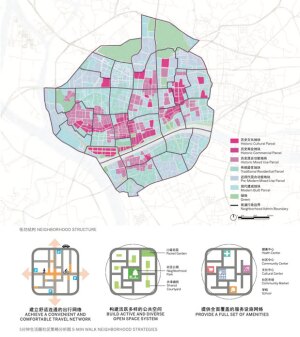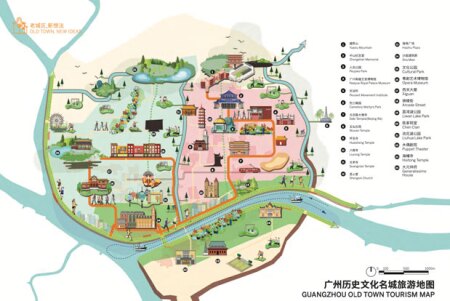In recent decades, SOM’s urban design work in China has created several successful old town redevelopment planning projects—such as Shanghai Xintiandi and Foshan Lingnan Tiandi—that integrate China’s ancient urban heritage into a new type of urban placemaking, one that celebrates local traditions while also creating immeasurable economic, social, and cultural value.
Guangzhou’s Old Town is the latest of these. Guangzhou is a national historical city with more than 2,200 years of history, an important center of indigenous Lingnan culture, and a significant port city, shaped over centuries by China’s foreign trade relations. But like so many other cities in China, rapid urbanization over the past 30 years has brought numerous challenges for its Old Town, including the loss of traditional architectural styles, human scale, historical fabric, and community identity. In addition, the poor condition of its old buildings and an overall cramped environment no longer meet people’s aspirations of an acceptable quality of life. As a result, its neighborhoods are experiencing population declines, especially among the younger demographic.
A Shared Vision
With 23 nationally designated heritage neighborhoods and more than 1,000 historical sites and buildings of various importance and conditions, Guangzhou Old Town is a complex place. Fortunately, much of the traditional urban fabric remains, and the area’s streets, tunnels, and many buildings and cultural relics are relatively well preserved. But Guangzhou planning officials saw an urgent need for a vision for the future of the old town, in order to develop action plans to improve the urban condition and preserve the valuable urban fabric, neighborhoods, and buildings in integrated, often micro-regenerative approaches.
To preserve and revitalize Guangzhou’s large Old Town area, we first held a series of in-depth consultations with residents and local businesses to gain a better understanding of this highly diverse place that gave birth to a global city. Together with local government, stakeholders helped craft a shared vision for a set of redevelopment principles that can be applied, stage by stage, to regenerate the 20-square-kilometer (8 sq mi) area, transforming it into cool new locations that will attract younger residents and tourists.
Sun Yue, the deputy director of Guangzhou’s planning bureau, characterized this stakeholder dialogue as the start of a new initiative to build a shared vision for the Old Town. This vision is based on six planning principles that were developed through this bottom-up public consultation to guide subsequent design work:
- Celebrate the “original Guangzhou”;
- Create a livable Old Town;
- Respect the neighborhoods’ diversity and uniqueness;
- Design a historic quarter that is very walkable;
- Support local businesses that are anchored to place; and
- Revive the dynamism in the Old Town.
SOM’s resulting award-winning Guangzhou Old Town Framework is not so much a master-plan design as a series of design strategies and development guidelines that will combine to revive the numerous old neighborhoods of the historic area, improve living standards, and restore its ecological condition.
Reconnecting the Lingnan City Roots
For thousands of years, the ancient city of Guangzhou has embraced its geographic origins of “Yun mountain and Zhu water.” The urban form of the Old Town follows the structure of most ancient Chinese cities, although it developed over time to integrate organically with the local Lingnan characteristics, which were well suited to the local climate. In more modern times, however, this small-scale and organic evolution could not adapt to the needs of a fast-growing, commercially focused city, and its integrity began to dissolve as modern development projects gradually displaced its buildings and residents, leaving islands of surviving historic areas as they encroached.
Stitching Together a Patchwork of Neighborhoods
The Old Town has hundreds of small neighborhoods of distinct and diverse character. To make regeneration work, the needs of each of these communities had to be understood and appreciated. While the overarching goal of redevelopment was to improve the living environment, the Framework Plan’s incrementable strategies also prioritized avoiding disintegration of neighborhood character.
The introduction of new public spaces sought to simultaneously enhance the value of historic building renovation and add value to heritage preservation investment. We allowed some of the dilapidated buildings to be reconstructed in an orderly manner with respect to the community scale, to form a mix of new and old buildings that can stimulate growth and promote the vitality and attractiveness of the community.
A Paradise for Pedestrians
Guangzhou Old Town’s unique character derives from the highly dense distribution of streets and lanes and its rich spatial variety. To further enhance the walking experience, planners sought to connect the existing streets, historical streets, arcade streets, tree-lined streets, and community alleys to create an integrated pedestrian network.
This network was then characterized with a unified signage system to create a series of Guangzhou-characteristic cultural trails, including, for example, an eight-kilometer (5 mi) historic walkway that connects popular cultural attractions, parks, business streets, museums, and the Pearl River waterfront landscape. These “branded” attractions are envisioned to draw more tourists and businesses to Old Town. In addition, the goal of improving the overall streetscape will be achieved by transforming the walking system into a network of connected public spaces, enhancing the environment of the historic area and improving property values.
A Cultural Economy Incubator
Guangzhou has a long history of commerce and trade: its world-renowned Canton Fair has for generations been China’s oldest and largest wholesale marketplace. This kind of broad-based economic activity contributed greatly to the vitality of the Old Town and to preserving the important international characteristics of Lingnan culture.
However, with the development of e-commerce in last decade, many local retailers have closed. To adapt to the reality of this new business model, the Regeneration Framework calls for upgrades of traditional stores that will transform the Old Town retail experience, with storefront spaces and uses becoming more flexible and more accessible.
To activate the shared public space, planners proposed connecting outer streets and inner lanes to provide increased accessibility for pedestrian traffic at ground level and create more shared public areas for various activities. Transforming and upgrading business locations and providing affordable rent should greatly help promote the development of innovative industries and attract the young knowledge workers they employ, thereby improving the community and its quality of life.
New Model for Chinese Old Town Redevelopment
Guangzhou Old Town is a new model for heritage regeneration in China that relies on engaging the public to build consensus among stakeholders based on local people’s understanding and respect for city history and its local culture. From that, it develops a publicly-supported framework for regeneration, with design strategies uniquely adapted to the historical city fabric and character. This innovative approach leverages local traditions, celebrates the vitality of the antiquity and modernity, activates economic transformation, and improves the quality of life of all who live and do business in China’s many other old town urban cores.











